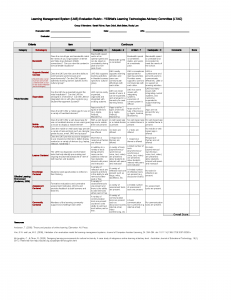Assignment
In your discussion group, develop a evaluation rubric for selecting an online delivery platform, either for K-12, community or higher education (your group will be assigned a scenario for one of these educational sectors). By Friday of next week, you will post your rubric as an attachment to a message in the discussion forum thread “Our group’s rubric”. In your attachment be sure to include:
- A précis of your group’s scenario
- Your detailed evaluation rubric, organized by categories
- A one paragraph articulation of why you included what you included, citing relevant literature
Response to YESNet Scenario
Group 3 Members
- Sarah Richer
- Ryan Dubé
- Mark Bates
- Rocky Lam
Précis of our Group’s Scenario
Yukon Education Student Network (YESNet) and Yukon First Nations Programs & Partnerships Unit of the Yukon’s Ministry of Education want to develop blended secondary courses that are relevant from an Aboriginal perspective.
The Na Cho Nyak Dun First Nation has agreed to pilot the program, but there are concerns about bandwidth and reliability of internet access in their traditional, unceded territories: many of its members rely on 3G technology, for example. If the pilot goes well the program will be rolled out across the Yukon’s other 12 First Nations.
As members of YESNet’s Learning Technologies Advisory Committee (LTAC) we have been tasked with developing an evaluation rubric to decide which LMS would best suit YESNet’s overall needs, given both current usage and possible upcoming expansion.
Articulation Statement
This rubric uses a criteria model focusing on how well the LMS is, “optimized for supporting important instructional activities” (Kim & Lee, 2007) instead of the traditional inventory-type evaluation framework (Stewart et al., 2007). The criteria has been modified to take into account the specific needs of the Yukon Education Student Network (YESNet) and Yukon First Nations Programs & Partnerships Unit of the Yukon’s Ministry of Education who want to develop blended secondary courses that are relevant from an Aboriginal social constructivist perspective (McLoughlin, C., & Oliver, R., 2000).
The analytic rubric is divided into two sections: Précis Mandate and Effective Learning Environment. These sections assess the functionality of the LMS based on an administration perspective as well as the level of interactive tools offered that enhance learning opportunities and interaction for the learner and educator. A scale is used from 0 to 3 to facilitate the scoring of each criterion to assess the overall quality and usefulness of the LMS for the Yukon Education Student Network and Ministry of Education unit but it is also applicable for other educational institutions. The results of the scoring assessment help to determine the aspects that are important to the investor and whether the LMS meets the needs of the community it is serving. **Specific weighting of subcategories within the Precis Mandate and Effective Learning Environment categories are recommended. Such weighting would, be based on a point scale, effectively allowing subcategories to be prioritized according to the user’s unique environment and needs.
Detailed Evaluation Rubric
Download PDF version of Delivery Platform Evaluation Rubric YESNet
References
Anderson, T. (2008). Towards a Theory of Online Learning. In The Theory and Practice of Online Learning (45-74). Edmonton: AU Press.
Kim, S.W. & Lee, M.G. (2008). Validation of an evaluation model for learning management systems. Journal of Computer Assisted Learning, 24: 284–294. doi:10.1111/j.1365-2729.2007.00260.x
McLoughlin, C., & Oliver, R. (2000). Designing learning environments for cultural inclusivity: A case study of indigenous online learning at tertiary level. Australian Journal of Educational Technology, 16(1), 58-72. Retrieved from http://ascilite.org.au/ajet/ajet16/mcloughlin.html
Bibliography
Caudill, J. (2007). The Growth of m-Learning and the Growth of Mobile Computing: Parallel developments. International Review of Research in Open and Distance Learning, 8(2), 1-13.
Kouninef, R., Tlemsani, S., Rerbal, M. & Lotfi, A. (2012). Developing a Mobile Learning Approach in Platform LMS INTTIC. Information Technology Journal, 11(8), 1131-1137.
Ozkan, S., & Koseler, R. (2009). Multi-dimensional students’ evaluation of e-learning systems in the higher education context: An empirical investigation. Computers & Education,53(4), 1285-1296. doi:10.1016/j.compedu.2009.06.011
Papastergiou, M. (2006). Course Management Systems as Tools for the Creation of Online Learning Environments: Evaluation from a Social Constructivist Perspective and Implications for their Design. International Journal On E-Learning,5(4), 593-622.
Stewart, B., Briton, D., Gismondi, M., Heller, B., Kennepohl, D., McGreal, R., & Nelson, C.(2007). Choosing MOODLE: An evaluation of learning management systems at Athabasca University. International Journal of Distance Education Technologies, 5(3), 1-7. Retrieved from http://search.proquest.com.ezproxy.library.ubc.ca/docview/201699778?accountid=14656


 Follow
Follow

Leave a Reply